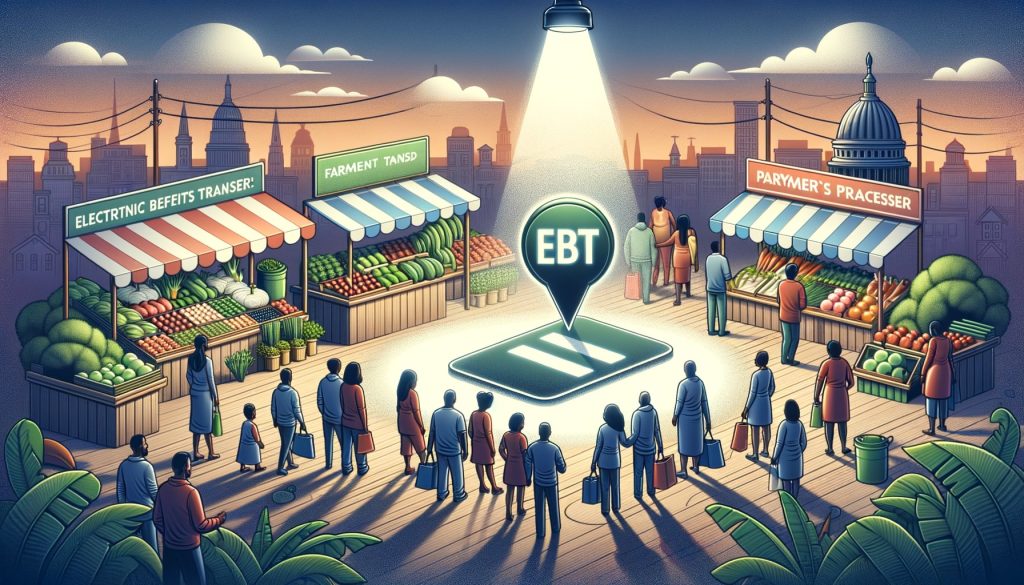
By Ethan Brooks November 21, 2024
In recent years, there has been a growing trend towards healthier eating and supporting local farmers. Farmer’s markets have become increasingly popular as consumers seek fresh, locally sourced produce. To cater to a wider customer base, many farmer’s markets are now accepting Electronic Benefit Transfer (EBT) payments.
EBT payment processing allows individuals who receive government assistance, such as Supplemental Nutrition Assistance Program (SNAP) benefits, to use their EBT cards to purchase fresh produce and other eligible food items at farmer’s markets.
This article will provide a comprehensive guide on how to set up EBT payment processing in a farmer’s market, including the benefits, step-by-step instructions, choosing the right EBT payment processor, obtaining necessary equipment, training staff, ensuring compliance, and promoting EBT payment acceptance.
Understanding the Benefits of Accepting EBT Payments

Accepting EBT payments at your farmer’s market can bring numerous benefits to both the market and the community it serves. Firstly, it allows individuals who rely on government assistance to access fresh, healthy food options. Many low-income families struggle to afford nutritious food, and by accepting EBT payments, farmer’s markets can help bridge this gap and promote healthier eating habits.
Secondly, accepting EBT payments can increase the customer base and revenue for farmer’s markets. According to the United States Department of Agriculture (USDA), SNAP participants spent over $22 billion on eligible food items at authorized retailers in 2020. By accepting EBT payments, farmer’s markets can tap into this significant market and attract a new segment of customers.
Furthermore, accepting EBT payments can enhance the market’s reputation as a community-focused and inclusive establishment. By providing access to fresh produce for all members of the community, regardless of their income level, farmer’s markets can foster a sense of inclusivity and social responsibility.
Step-by-Step Guide: Setting Up EBT Payment Processing

Setting up EBT payment processing in a farmer’s market involves several steps. Here is a step-by-step guide to help you navigate the process:
- Determine eligibility: Before proceeding with EBT payment processing, ensure that your farmer’s market meets the eligibility criteria set by the USDA. This includes being an authorized SNAP retailer and selling eligible food items.
- Obtain a USDA FNS number: To accept EBT payments, you need to obtain a USDA Food and Nutrition Service (FNS) number. This number is unique to your farmer’s market and is required for EBT payment processing.
- Choose an EBT payment processor: Select a reputable EBT payment processor that specializes in serving farmer’s markets. Consider factors such as fees, customer support, and integration options with your existing point-of-sale (POS) system.
- Complete the application process: Work with your chosen EBT payment processor to complete the application process. This typically involves providing information about your farmer’s market, including your FNS number, business details, and banking information.
- Obtain necessary equipment: Purchase or lease the necessary equipment to process EBT payments. This includes a POS system capable of accepting EBT cards and a card reader or terminal.
- Train staff: Train your staff on the procedures for processing EBT payments. Ensure they understand how to operate the POS system, process EBT transactions, and handle any potential issues that may arise.
- Test the system: Before officially launching EBT payment processing at your farmer’s market, conduct thorough testing to ensure the system is functioning correctly. This includes processing test transactions and verifying that funds are properly credited to your account.
- Promote EBT payment acceptance: Once your EBT payment processing system is up and running, promote its availability at your farmer’s market. Utilize signage, social media, and other marketing channels to inform the community about this convenient payment option.
Choosing the Right EBT Payment Processor for Your Farmer’s Market

Choosing the right EBT payment processor is crucial for a smooth and efficient payment processing experience at your farmer’s market. Consider the following factors when selecting a processor:
- Experience and expertise: Look for a payment processor with experience in serving farmer’s markets. They should have a deep understanding of the unique needs and requirements of these establishments.
- Integration options: Ensure that the EBT payment processor can seamlessly integrate with your existing POS system. This will streamline the payment process and minimize disruptions to your operations.
- Fees and pricing structure: Compare the fees and pricing structures of different EBT payment processors. Consider factors such as transaction fees, monthly fees, and any additional charges for equipment or support services.
- Customer support: Evaluate the level of customer support provided by the EBT payment processor. Prompt and reliable support is essential in case of any technical issues or questions that may arise.
- Security measures: Verify that the EBT payment processor has robust security measures in place to protect sensitive customer data. This includes encryption protocols and compliance with Payment Card Industry Data Security Standard (PCI DSS) requirements.
Obtaining the Necessary Equipment for EBT Payment Processing

To successfully process EBT payments at your farmer’s market, you will need the following equipment:
- Point-of-sale (POS) system: Invest in a POS system that is capable of accepting EBT cards. The POS system should integrate with your chosen EBT payment processor and have the necessary software to process EBT transactions.
- Card reader or terminal: Purchase or lease a card reader or terminal specifically designed for EBT payments. These devices allow customers to swipe or insert their EBT cards and enter their PINs securely.
- Internet connection: Ensure that you have a stable and reliable internet connection at your farmer’s market. This is necessary for real-time transaction processing and communication with the EBT payment processor.
- Receipt printer: Invest in a receipt printer to provide customers with printed receipts for their EBT transactions. This adds a professional touch to the payment process and allows customers to keep track of their purchases.
Training Staff on EBT Payment Processing Procedures
Properly training your staff on EBT payment processing procedures is essential to ensure smooth operations and excellent customer service. Here are some key steps to consider when training your staff:
- Familiarize staff with EBT program regulations: Provide an overview of the EBT program regulations, including eligible food items, transaction limits, and customer rights. This will help staff understand the rules and requirements associated with EBT payment processing.
- Demonstrate POS system operation: Train staff on how to operate the POS system for EBT payments. This includes logging in, selecting the EBT payment option, and processing transactions. Ensure they are comfortable navigating the system and can troubleshoot common issues.
- Practice handling EBT cards: Teach staff how to handle EBT cards securely and professionally. Emphasize the importance of protecting customer privacy and ensuring the confidentiality of PINs.
- Role-play different scenarios: Conduct role-playing exercises to simulate various customer interactions and potential challenges. This will help staff develop problem-solving skills and handle different situations confidently.
- Provide ongoing support and feedback: Offer ongoing support to staff as they become familiar with EBT payment processing. Encourage open communication and provide feedback to help them improve their skills and address any issues that arise.
Ensuring Compliance with EBT Program Regulations
Compliance with EBT program regulations is crucial to maintain eligibility as an authorized SNAP retailer and avoid penalties or sanctions. Here are some key steps to ensure compliance:
- Stay updated on program changes: Regularly review updates and changes to EBT program regulations. The USDA and state agencies may introduce new requirements or modify existing ones. Stay informed to ensure your farmer’s market remains compliant.
- Train staff on compliance requirements: Educate your staff on the specific compliance requirements associated with EBT payment processing. This includes understanding eligible food items, transaction limits, and customer rights.
- Maintain accurate records: Keep detailed records of EBT transactions, including receipts, transaction logs, and reconciliation reports. This documentation will be essential for audits and compliance verification.
- Conduct internal audits: Regularly conduct internal audits to ensure compliance with EBT program regulations. This involves reviewing transaction records, verifying inventory, and assessing staff adherence to procedures.
- Cooperate with inspections and audits: Cooperate fully with any inspections or audits conducted by the USDA or state agencies. Provide requested documentation and address any issues or recommendations promptly.
Promoting EBT Payment Acceptance at Your Farmer’s Market
To maximize the benefits of accepting EBT payments at your farmer’s market, it is essential to promote this payment option effectively. Here are some strategies to consider:
- Signage and displays: Clearly display signs and banners at your farmer’s market indicating that EBT payments are accepted. Place these signs at prominent locations to attract the attention of potential customers.
- Social media and website promotion: Utilize your farmer’s market’s social media platforms and website to promote EBT payment acceptance. Create engaging posts and share success stories of individuals who have benefited from using EBT at your market.
- Collaborate with local organizations: Partner with local organizations that support low-income individuals and families. Collaborate on joint marketing efforts to raise awareness about EBT payment acceptance at your farmer’s market.
- Offer incentives: Consider offering incentives to EBT customers to encourage their participation. This could include discounts, loyalty programs, or special promotions exclusively for EBT users.
- Community outreach: Engage with the community through outreach programs and events. Attend local fairs, festivals, and community gatherings to spread the word about EBT payment acceptance and the benefits of shopping at your farmer’s market.
Frequently Asked Questions
Q1: What is EBT payment processing?
EBT payment processing refers to the ability to accept Electronic Benefit Transfer (EBT) payments at a merchant establishment, such as a farmer’s market. EBT payments are made using a government-issued card, similar to a debit card, and are used by individuals who receive government assistance, such as SNAP benefits.
Q2: How can accepting EBT payments benefit my farmer’s market?
Accepting EBT payments can benefit your farmer’s market in several ways. It allows individuals who rely on government assistance to access fresh, healthy food options. It can also increase your customer base and revenue by tapping into the significant market of SNAP participants. Additionally, accepting EBT payments enhances your market’s reputation as an inclusive establishment that supports the community.
Q3: How do I obtain a USDA FNS number?
To obtain a USDA Food and Nutrition Service (FNS) number, you need to complete an application process with the USDA. The application typically requires information about your farmer’s market, including your business details, FNS number, and banking information. Contact the USDA or visit their website for more information on the application process.
Q4: What equipment do I need for EBT payment processing?
To process EBT payments at your farmer’s market, you will need a point-of-sale (POS) system capable of accepting EBT cards, a card reader or terminal, an internet connection, and a receipt printer. These equipment components work together to facilitate secure and efficient EBT payment processing.
Q5: How can I ensure compliance with EBT program regulations?
To ensure compliance with EBT program regulations, stay updated on program changes, train your staff on compliance requirements, maintain accurate records of EBT transactions, conduct internal audits, and cooperate fully with inspections and audits conducted by the USDA or state agencies.
Conclusion
Setting up EBT payment processing in a farmer’s market can bring numerous benefits to both the market and the community it serves. By accepting EBT payments, farmer’s markets can provide access to fresh, healthy food options for individuals who rely on government assistance. This not only promotes healthier eating habits but also increases the customer base and revenue for the market.
By following the step-by-step guide outlined in this article, choosing the right EBT payment processor, obtaining the necessary equipment, training staff, ensuring compliance, and promoting EBT payment acceptance, farmer’s markets can successfully implement EBT payment processing and contribute to a more inclusive and sustainable food system.